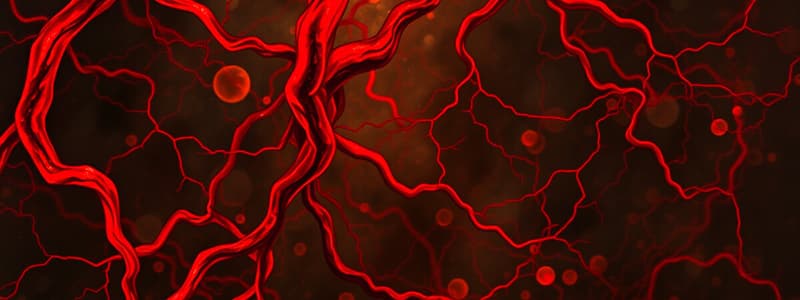Podcast
Questions and Answers
Which factor is primarily associated with increased blood viscosity affecting the pressure gradient?
Which factor is primarily associated with increased blood viscosity affecting the pressure gradient?
- Stroke volume
- Capillary blood flow
- Hematocrit (correct)
- Diastolic blood pressure
In a patient with polycythemia, which measurement would be expected to increase due to elevated hematocrit levels?
In a patient with polycythemia, which measurement would be expected to increase due to elevated hematocrit levels?
- Mean blood pressure (correct)
- Central venous pressure
- Capillary blood flow
- Radius of the resistance vessels
Which type of blood flow is characterized by a smooth and steady rate through long blood vessels?
Which type of blood flow is characterized by a smooth and steady rate through long blood vessels?
- Streamline flow
- Turbulent flow
- Laminar flow (correct)
- Eddy current
What term describes the arrangement that permits independent regulation of blood flow to different tissues?
What term describes the arrangement that permits independent regulation of blood flow to different tissues?
Which vessels have the highest total cross-sectional area in the human body?
Which vessels have the highest total cross-sectional area in the human body?
Reynaud’s number is used to measure what aspect of blood flow?
Reynaud’s number is used to measure what aspect of blood flow?
Which factor is least likely to directly affect the viscosity of the blood?
Which factor is least likely to directly affect the viscosity of the blood?
In terms of vascular resistance, which of the following has the least impact on blood flow dynamics?
In terms of vascular resistance, which of the following has the least impact on blood flow dynamics?
What unit is commonly used to measure conductance in terms of blood flow?
What unit is commonly used to measure conductance in terms of blood flow?
Which factor has the least impact on the rate of blood flow through a vessel?
Which factor has the least impact on the rate of blood flow through a vessel?
How does the rate of blood flow change with the radius of the vessel?
How does the rate of blood flow change with the radius of the vessel?
If the viscosity of blood increases, what effect would this have on conductance?
If the viscosity of blood increases, what effect would this have on conductance?
What describes the relationship between conductance and vessel diameter?
What describes the relationship between conductance and vessel diameter?
Which of the following statements about blood flow and vessel length is true?
Which of the following statements about blood flow and vessel length is true?
What parameter is inversely related to resistance in blood flow?
What parameter is inversely related to resistance in blood flow?
When the diameter of a blood vessel doubles, how does the conductance change?
When the diameter of a blood vessel doubles, how does the conductance change?
What primarily initiates the activation of compensatory mechanisms in response to increased arterial pressure?
What primarily initiates the activation of compensatory mechanisms in response to increased arterial pressure?
During the event of changes in arterial pressure, what is the main mechanism by which tissues maintain normal blood flow?
During the event of changes in arterial pressure, what is the main mechanism by which tissues maintain normal blood flow?
What effect does sympathetic stimulation generally have on blood vessels?
What effect does sympathetic stimulation generally have on blood vessels?
Which of the following factors is NOT primarily significant in hemodynamic studies of blood viscosity?
Which of the following factors is NOT primarily significant in hemodynamic studies of blood viscosity?
How do strong sympathetic stimulation and hormonal vasoconstrictors affect blood flow?
How do strong sympathetic stimulation and hormonal vasoconstrictors affect blood flow?
What is observed during the inhibition of sympathetic stimulation regarding blood vessels?
What is observed during the inhibition of sympathetic stimulation regarding blood vessels?
What is the approximate range of arterial pressure during which blood flow autoregulation occurs?
What is the approximate range of arterial pressure during which blood flow autoregulation occurs?
Which of the following components does NOT contribute to increased blood viscosity?
Which of the following components does NOT contribute to increased blood viscosity?
What is the primary function of the blood vessels with the highest cross-sectional area?
What is the primary function of the blood vessels with the highest cross-sectional area?
How does blood velocity in the aorta compare to that in the capillaries?
How does blood velocity in the aorta compare to that in the capillaries?
What must be maintained for normal diffusion of nutrients in the capillaries?
What must be maintained for normal diffusion of nutrients in the capillaries?
What phenomenon occurs due to the lower blood flow velocity in capillaries?
What phenomenon occurs due to the lower blood flow velocity in capillaries?
What is the reason capillaries have the highest cross-sectional area?
What is the reason capillaries have the highest cross-sectional area?
Which statement best describes the relationship between cross-sectional area and blood flow velocity?
Which statement best describes the relationship between cross-sectional area and blood flow velocity?
Why do capillaries only retain blood for a short duration?
Why do capillaries only retain blood for a short duration?
What is a characteristic of blood velocity in venous segments compared to the aorta?
What is a characteristic of blood velocity in venous segments compared to the aorta?
How does the diameter of a blood vessel affect its conductance?
How does the diameter of a blood vessel affect its conductance?
What effect does a larger diameter have on blood flow?
What effect does a larger diameter have on blood flow?
In which condition would you expect blood vessels to dilate, requiring higher flow for normal blood pressure?
In which condition would you expect blood vessels to dilate, requiring higher flow for normal blood pressure?
What is the relationship between blood flow, vessel diameter, and pressure in a state of obstructed flow like aortic stenosis?
What is the relationship between blood flow, vessel diameter, and pressure in a state of obstructed flow like aortic stenosis?
What is the immediate effect of increased viscosity in blood on its flow?
What is the immediate effect of increased viscosity in blood on its flow?
What is the outcome of post-stenotic dilation in calcific aortic stenosis?
What is the outcome of post-stenotic dilation in calcific aortic stenosis?
What does an increase in vessel diameter signify in terms of flow conductance?
What does an increase in vessel diameter signify in terms of flow conductance?
Which process is essential for maintaining normal blood pressure when the diameter of a blood vessel increases?
Which process is essential for maintaining normal blood pressure when the diameter of a blood vessel increases?
Flashcards are hidden until you start studying
Study Notes
Diffusion and Blood Flow Dynamics
- Diffusion of substances between blood and tissues is essential for nutrient exchange.
- Aorta and capillaries maintain the same blood flow despite their size differences; this is due to the largest cross-sectional area in capillaries.
- Average blood velocity in the aorta is 33 cm/sec, while in capillaries, it drops to about 0.3 mm/sec, allowing for effective substance diffusion.
- Blood remains in capillaries for only 1 to 3 seconds, supporting fast nutrient transport.
Conductance of Blood in Vessels
- Conductance measures blood flow for a given pressure difference in a vessel.
- Expressed in (ml/sec mm Hg) or (L/sec mm Hg), showing blood flow efficiency.
- Increasing vessel radius enhances flow significantly—flow is proportional to the fourth power of the vessel radius.
- Resistance inversely affects flow; higher viscosity decreases flow.
Factors Affecting Blood Flow
- Diameter changes greatly influence conductance; dilation increases conductance, and obstruction can lead to higher pressure to maintain normal flow.
- High hematocrit leads to decreased flow, slowing hemodynamics in vessels.
- Minor factors impacting blood viscosity: plasma protein concentration and types of proteins present.
Effects of Pressure on Vascular Resistance
- Increased arterial pressure activates compensatory mechanisms, including vascular resistance adjustments.
- Blood flow autoregulation maintains normal flow during arterial pressure changes (approximately 70 to 175 mm Hg).
- Strong sympathetic stimulation causes vasoconstriction, potentially reducing blood flow even when arterial pressure rises; hormonal factors also play a role.
Key Blood Flow Concepts
- Diastolic blood pressure, viscosity, vascular resistance, hematocrit, and capillary blood flow are crucial in understanding steady blood flow rates.
- In conditions like polycythemia (high hematocrit), mean blood pressure typically increases due to elevated blood viscosity.
- Capillaries have the highest total cross-sectional area in the circulatory system, supporting their role in nutrient exchange and blood flow regulation.
Studying That Suits You
Use AI to generate personalized quizzes and flashcards to suit your learning preferences.




